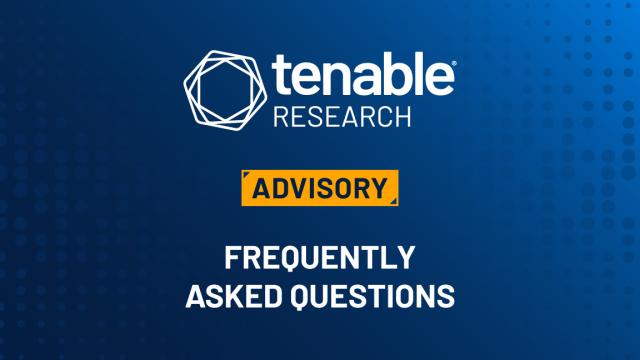Frequently Asked Questions about ScreenConnect Vulnerabilities
by nlqip

Frequently asked questions about two vulnerabilities affecting ConnectWise ScreenConnect
Update February 23: The blog has been updated to include information about ransomware attacks involving vulnerable ScreenConnect servers.
Background
The Tenable Security Response Team has put together this blog to answer Frequently Asked Questions (FAQ) regarding two vulnerabilities impacting ScreenConnect, a Remote Monitoring and Management (RMM) solution from ConnectWise.
FAQ
What are the ScreenConnect vulnerabilities and when were they disclosed?
On February 19, ConnectWise released a security advisory for two vulnerabilities affecting their RMM product, ScreenConnect. At the time the advisory was released, no CVE identifiers had been released for the vulnerabilities. On February 21, three CVEs were assigned for these vulnerabilities. Two CVEs were reserved by the U.S. Cybersecurity and Infrastructure Security Agency (CISA) (CVE-2024-1708 and CVE-2024-1709) and another was reserved by MITRE (CVE-2024-27215). CVE-2024-27215 was later updated and listed as REJECTED.
| CVE | Description | CVSSv3 |
|---|---|---|
| CVE-2024-1709 | Authentication bypass that could allow an attacker to execute remote code or directly impact confidential data or critical systems. | 10 |
| CVE-2024-1708 | A path traversal vulnerability that could allow an attacker to access confidential data | 8.4 |
Which versions of ConnectWise are affected?
ScreenConnect versions 23.9.7 and prior are affected by these vulnerabilities. These vulnerabilities only impact self-hosted or on-premise installations. Cloud customers who have ScreenConnect servers hosted on the “screenconnect.com” or “hostedrmm.com” are not impacted as updates have been made to the cloud service to address these vulnerabilities.
The advisory also notes that updated versions of ScreenConnect 22.4 through 23.9.7 will be released, however they still strongly recommend upgrading to ScreenConnect version 23.9.8.
Have any of these vulnerabilities been exploited?
On February 20, ConnectWise updated its security advisory to share indicators of compromise (IOCs) relating to malicious activity. In this update, ConnectWise notes that they have “received updates of compromised accounts” that were investigated and confirmed by its incident response team, indicating in-the-wild exploitation of these flaws. The update includes IOCs of IP addresses reportedly associated with threat actor activity.
On February 20, Huntress posted a blog post with detection guidance to aid defenders into identifying impacted systems.
On February 23, Sophos reported that ransomware attacks have been observed exploiting vulnerable ScreenConnect servers. A variant of the LockBit ransomware known as buhtiRansom has been observed and according to Sophos, this variant appears to have been generated using the leaked LockBit builder. As ransomware groups and affiliates begin targeting vulnerable instances of ScreenConnect, it’s imperative that immediate action is taken to remediate these vulnerabilities.
Has any Proof-of-Concept (PoC) code been released?
As of February 20, a blog by Huntress indicates that their researchers have reproduced these vulnerabilities and developed a working PoC, however they have chosen not to release the exploit code. Later that day, Huntress posted another blog post with their analysis of the vulnerabilities as well as how they discovered them. This blog included information on how to exploit these vulnerabilities citing that other vendors have released their own PoCs and that “the cat is out of the bag.”
In addition to Huntress, researchers at Horizon3 Attack Team posted to X (formerly known as Twitter) about their own PoC for the authentication bypass vulnerability, adding that it is “extremely trivial to reverse and exploit” that they plan to publish it along with a blog post soon.
The recent #ConnectWise #ScreenConnect authentication bypass vulnerability is extremely trivial to reverse and exploit. Blog and exploit POC will drop soon. pic.twitter.com/mEIaRetKxQ
— Horizon3 Attack Team (@Horizon3Attack) February 20, 2024
On February 21, Horizon3 released their write up and PoC and researchers at watchTowr posted on X that they have created a PoC for the authentication bypass issue and posted a link to their PoC on GitHub.
Here’s our PoC for the Connectwise ScreenConnect Auth Bypass:https://t.co/C17vJWygf6
The vuln is the definition of trivial and thus we won’t release any analysis. Not sure what we would share – “Add a / and you too can pwn the world”? pic.twitter.com/oVh2LNCqb6
— watchTowr (@watchtowrcyber) February 21, 2024
Are patches or mitigations available?
As of February 19 when the security advisory was released, ScreenConnect version 23.9.8 has been released to address these vulnerabilities. No mitigation steps were provided by ConnectWise.
Has Tenable released any product coverage for these vulnerabilities?
Yes, product coverage for these vulnerabilities is now available in the following plugins:
Additional coverage can be found on the individual CVE pages for CVE-2024-1708 and CVE-2024-1709 as they’re released. This link will display all available plugins for this vulnerability, including upcoming plugins in our Plugins Pipeline.
Get more information
Change Log
Update February 23: The blog has been updated to include information about ransomware attacks involving vulnerable ScreenConnect servers.
Update February 22: The blog has been updated with Tenable product coverage.
Update February 21 (Second Update): The blog has been updated to announce that CVE identifiers have been reserved for these vulnerabilities.
Update February 21: The blog has been updated to announce that public proof-of-concept code is now available.
Update February 20: The blog has been updated with confirmation from ConnectWise of in-the-wild exploitation.
Join Tenable’s Security Response Team on the Tenable Community.
Learn more about Tenable One, the Exposure Management Platform for the modern attack surface.
Source link
lol
Frequently asked questions about two vulnerabilities affecting ConnectWise ScreenConnect Update February 23: The blog has been updated to include information about ransomware attacks involving vulnerable ScreenConnect servers. View Change Log Background The Tenable Security Response Team has put together this blog to answer Frequently Asked Questions (FAQ) regarding two vulnerabilities impacting ScreenConnect, a Remote Monitoring…
Recent Posts
- Arm To Seek Retrial In Qualcomm Case After Mixed Verdict
- Jury Sides With Qualcomm Over Arm In Case Related To Snapdragon X PC Chips
- Equinix Makes Dell AI Factory With Nvidia Available Through Partners
- AMD’s EPYC CPU Boss Seeks To Push Into SMB, Midmarket With Partners
- Fortinet Releases Security Updates for FortiManager | CISA
